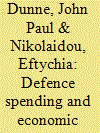| Srl | Item |
| 1 |
ID:
116060


|
|
|
|
|
| Publication |
2012.
|
| Summary/Abstract |
Over the last 30?years, there has been an impressive amount of empirical work on the defence-growth nexus, using different methodologies, models and econometric techniques and focusing on individual case studies, cross-country studies or panel data studies. Despite the number and the variety of studies, the evidence on the defence-growth relationship is still far from conclusive. Rather surprisingly, very limited work has been published in the relevant literature for the European Union despite the continuous discussions for a Common European Defence Policy that would require an assessment of the economic effects of defence in this region. To fill in the gap in the literature, this paper employs an augmented Solow-Swan model and estimates it both with panel and time series methods to provide empirical evidence on the economic effects of defence spending in the EU15 over the period 1961-2007. Overall, evidence derived from both panel and time series methods is consistent and suggests that military burden does not promote economic growth in this region.
|
|
|
|
|
|
|
|
|
|
|
|
|
|
|
|
| 2 |
ID:
177378


|
|
|
|
|
| Summary/Abstract |
The EU is committed to become climate-neutral by 2050 while keeping its prosperity intact. To align the bloc towards this goal, it is fundamental to understand the spatial differences in energy performance among its members. The present study aims to identify the main drivers of primary energy intensity differences among fourteen European countries (i.e., the EU15 without Luxemburg) during the period 2000–2010. To do so, we apply for the first time the multi-factor energy input-output model to spatial structural decomposition analysis. The results show that differences in the industrial direct energy intensity and in the mix of final energy demand were the driving factors of primary energy intensity differences among countries, while, remarkably, structural differences in both the energy sector and in the rest of the economy were not as relevant. This implies that deepening industrial and residential efficiency policies should be a key objective in addition to the current policy efforts to deploy renewables in the energy sector. In addition, we show that the proposed approach helps overcome the main shortcomings of conventional spatial decomposition approaches, e.g., the inconsistent accounting of energy conversion processes in the economy; and its detailed results can be translated into more effective policy making.
|
|
|
|
|
|
|
|
|
|
|
|
|
|
|
|